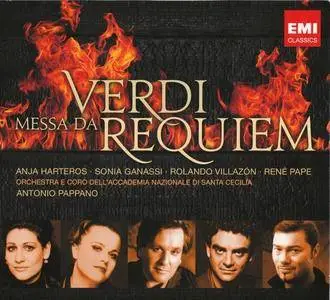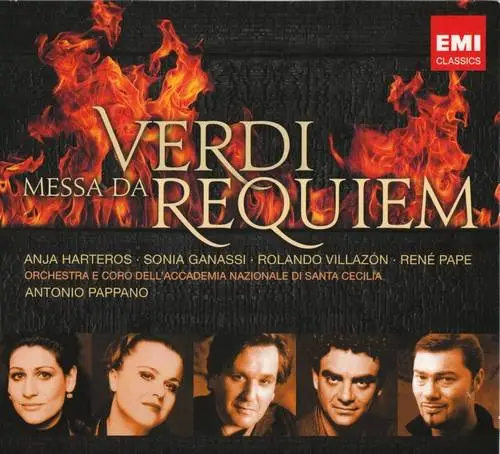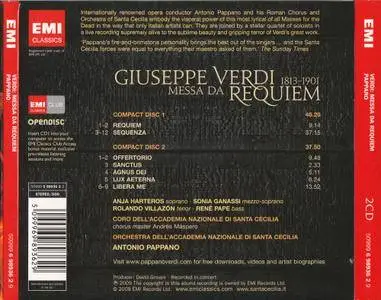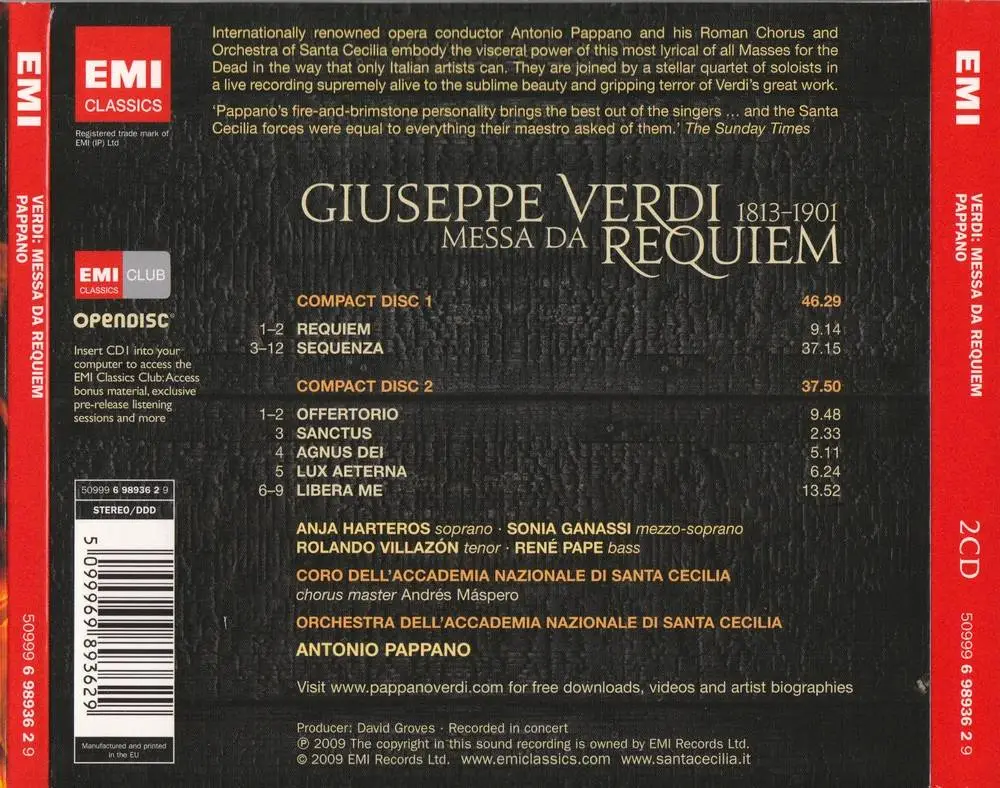Anja Harteros, Sonia Ganassi, Rolando Villazon, Rene Pape, Antonio Pappano – Verdi: Messa da Requiem (2009)
EAC | APE (image+.cue, log) | Covers Included | 86:19 | 422 MB
Genre: Classical, Sacred | Label: EMI Classics | Catalog: 6 98936 2
EAC | APE (image+.cue, log) | Covers Included | 86:19 | 422 MB
Genre: Classical, Sacred | Label: EMI Classics | Catalog: 6 98936 2
The Verdi Messa da Requiem is probably the best known Requiem in the repertoire. Many great conductors have recorded it. I’m thinking of Toscanini at New York/1951, Victor De Sabata at Milan/1954 and probably the best known of all Carlo-Maria Giulini at London/1964-65. Some more recent versions have proved popular notably John Eliot Gardiner using period instruments in London/1992, Claudio Abbado at Berlin/2001 and also Nikolaus Harnoncourt at Vienna/2004. Now Antonio Pappano, currently music director of the Royal Opera House, Covent Garden has recorded the score for EMI Classics. British-born of Italian parentage, maestro Pappano clearly has an affinity with the score and has produced a performance that can rival the very best in the catalogues.
The Messa da Requiem has a fascinating history. The score was conceived by Verdi in 1868 as a tribute to Rossini following his death in Paris. Verdi suggested that composers of Italy should unite in honour of Rossini. The plan was developed that each composer would collaborate gratis contributing part of a Requiem to be performed once only at Bologna on the first anniversary of Rossini’s death. Verdi contributed the closing section: the Libera me, Domine. Preparations were put in place however, the collaborative project experienced difficulties and never came to fruition.
Some five years later Verdi gained an unexpected stimulus to compose a Requiem Mass. As a young man Verdi had been captivated by Alessandro Manzoni’s famous novel, I promessi sposi (The Betrothed). Verdi wrote of Manzoni in 1868, “I would have knelt before him if it was permissible to worship men.” At Milan in May 1873 the 88 years old Manzoni on his way to early morning mass tripped and fell on the steps of the San Fedele church only to die a few months later. Verdi inconsolable said he was too moved to attend the funeral. A week later he travelled to Milan to visit the grave alone and pay his personal homage. Within a few weeks he quickly announced to the mayor of Milan his intention to compose a Messa da Requiem in remembrance of Manzoni. At this time the 60 year old Verdi was at the height of his creative powers having recently had his opera Aïda premiered in Cairo with only Otello and Falstaff yet to be composed. Expectations were high. The Milanese authorities gave their approval to the project agreeing to pay for the one-off performance costs. Their only stipulation being that the Messa da Requiem had to be premiered in Milan and on the anniversary of Manzoni’s death. Verdi already had the important closing section written for the Rossini Requiem although it seems that he virtually rewrote it. By April 1874 the Requiem was completed and the score despatched to publisher Ricordi. For its favourable acoustics and proportions adequate for his 120 voice choir and 100 strong orchestral Verdi chose the church of San Marco as the location for the Milan performance. On 22 May 1874, the anniversary of Manzoni’s death, the Messa da Requiem was successfully given under Verdi’s baton. The San Marco church could not hold a large congregation and many people failed to gain entry. Verdi conducted another performance three days later at La Scala opera house with an additional two performances conducted by Franco Faccio.
The Messa da Requiem was subsequently acclaimed both in Italy and widely around Europe. In Italy the Messa da Requiem became so popular that it was often played in various guises ranging from arrangements for military bands or transcriptions for four pianos. Critical opinion was generally in sympathy with the Messa da Requiem. Many observers shared Brahms’ opinion that, “Only a genius could have written such a work.” Some commentators were far less enamoured of the score feeling that Verdi’s dramatic music, that felt operatic at times, was not in keeping with a text essentially based on the liturgical Roman Catholic Latin Mass for the Dead. Verdi was certainly not a practising Roman Catholic and in truth was possibly an agnostic if not a total unbeliever. Biographer Eric Blom stated that Verdi, “though not a reformer, is a liberal minded catholic.” Strengthening accusations of insincerity the renowned conductor Hans von Bülow described the score as, “An opera in ecclesiastical garb.” Francis Toye, another Verdi biographer, expressed the view that the work, “… is not really an ecclesiastical composition at all but a utilisation by a master of drama of the words of the liturgy to express the most profound emotions of the composer.” Wagner, never usually lost for words, is reported to have said, simply, “It is better to say nothing …”
The influence of the Cecilian movement in Italy would have undoubtedly been a factor in whipping up often extreme reactions to Verdi’s Messa da Requiem. The
Church reform movement wanted to rid the Roman Catholic Church of a growing trend towards a more theatrical style of music and the influence of secularism by returning to more the traditional ideals of Gregorian chant and Renaissance polyphony.
Maestro Pappano is musical director of Santa Cecilia in addition to his Covent Garden position. In an exceptional performance Pappano’s Roman chorus and orchestra are conducted with power, assurance and precision. I was struck by its sheer intensity. Of the many highlights I especially enjoyed the Dies Irae: spine-tingling and terrifying depiction of judgement day.
Pappano has assembled a splendidly contrasted quartet of soloists who rise wonderfully to the challenges of the occasion. Winner of the Cardiff Singer of the World Competition in 1999, German-born Anja Harteros is a radiant soprano of the highest quality. Her silky tone is of the utmost purity and her control is impeccable. Sonia Ganassi the velvety and light-toned Italian mezzo is expressive with the rare ability truly to move the listener. Under pressure her vibrato is noticeable but never intrusive. International star tenor Rolando Villazón is in fine voice and is most convincing in conveying a devotional quality to his interpretation. I note that Villazón is recuperating after surgery on his vocal chords shortly after this recording was made and is hoping to return next year. For me the stand-out performance is from René Pape who just gets better and better. The rich tones of the German bass radiate dark character with a convincing sense of authority.
Antonio Pappano made this recording for EMI earlier this year at the relatively newly constructed Auditorium Parco della Musica at Sala Santa Cecilia in Rome. The sound quality is clear with a wide dynamic range. On account of the ridiculously quiet start I could not hear the music for around forty-five seconds into the disc. Playing the disc whilst driving in the car it was over two minutes before the music became reasonably audible. Few people would have failed to have reached for the volume control. I enjoyed the excellent essay in the booklet from Stephen Jay-Taylor.
With this EMI set Pappano proves himself a Verdi conductor of great stature. He has produced a scorching performance that can rival the very best in the catalogue. – Michael Cookson
Track List:
CD 1:
01. Requiem: Requiem
02. Requiem: Kyrie Eleison
03. Sequenza: Dies Irae
04. Sequenza: Tuba Mirum
05. Sequenza: Mors Stupebit
06. Sequenza: Liber Scriptus - Dies Irae
07. Sequenza: Quid Sum Miser
08. Sequenza: Rex Tremendae
09. Sequenza: Recordare
10. Sequenza: Ingemisco
11. Sequenza: Confutatis - Dies Irae
12. Sequenza: Lacrymosa
V0.99 prebeta 5 from 4. May 2009
Journal d'extraction EAC depuis 12. Octobre 2009, 18:39
Artiste inconnu / Titre inconnu
Lecteur utilis� : TSSTcorpCDDVDW SH-S203B Adapter: 4 ID: 0
Mode lecture : :
: Oui
: Non
: Non
Correction Offset Ecriture : : 6
Lecture �tendue en Lead-In et Lead-Out : Non
Remplacer les samples manquants par du silence : Oui
Effacer les blocs silencieux situ�s en d�but et fin : Non
: Non
: Interface Native Win32 pour Win NT & 2000
Format de sortie utilis� : : Routines WAV interne
: 44.100 Hz; 16 Bit; St�r�o
| | | |
––––––––––––––––––––––
1 | 0:00.00 | 5:35.24 | 0 | 25148
2 | 5:35.24 | 3:38.70 | 25149 | 41568
3 | 9:14.19 | 2:14.46 | 41569 | 51664
4 | 11:28.65 | 1:55.01 | 51665 | 60290
5 | 13:23.66 | 1:20.00 | 60291 | 66290
6 | 14:43.66 | 5:01.13 | 66291 | 88878
7 | 19:45.04 | 3:45.04 | 88879 | 105757
8 | 23:30.08 | 3:46.18 | 105758 | 122725
9 | 27:16.26 | 4:03.26 | 122726 | 140976
10 | 31:19.52 | 3:33.59 | 140977 | 157010
11 | 34:53.36 | 5:19.03 | 157011 | 180938
12 | 40:12.39 | 6:19.10 | 180939 | 209373
Propri�t�s Etats et Erreurs
Gammes s�lectionn�es
Nom fichier E:\Klassik up\verdi\Requiem\VMDRP1\Artiste inconnu - Titre inconnu.wav
Niveau Max 98.8 %
qualit� intervalle 99.9 %
Copie CRC AF5A0784
Copie Ok
Pas d'erreur apparue
Piste 1
Piste 2
Piste 3
Piste 4
Piste 5
Piste 6
Piste 7
Piste 8
Piste 9
Piste 10
Piste 11
Piste 12
Fin du rapport d'�tat
Journal d'extraction EAC depuis 12. Octobre 2009, 18:39
Artiste inconnu / Titre inconnu
Lecteur utilis� : TSSTcorpCDDVDW SH-S203B Adapter: 4 ID: 0
Mode lecture : :
: Oui
: Non
: Non
Correction Offset Ecriture : : 6
Lecture �tendue en Lead-In et Lead-Out : Non
Remplacer les samples manquants par du silence : Oui
Effacer les blocs silencieux situ�s en d�but et fin : Non
: Non
: Interface Native Win32 pour Win NT & 2000
Format de sortie utilis� : : Routines WAV interne
: 44.100 Hz; 16 Bit; St�r�o
| | | |
––––––––––––––––––––––
1 | 0:00.00 | 5:35.24 | 0 | 25148
2 | 5:35.24 | 3:38.70 | 25149 | 41568
3 | 9:14.19 | 2:14.46 | 41569 | 51664
4 | 11:28.65 | 1:55.01 | 51665 | 60290
5 | 13:23.66 | 1:20.00 | 60291 | 66290
6 | 14:43.66 | 5:01.13 | 66291 | 88878
7 | 19:45.04 | 3:45.04 | 88879 | 105757
8 | 23:30.08 | 3:46.18 | 105758 | 122725
9 | 27:16.26 | 4:03.26 | 122726 | 140976
10 | 31:19.52 | 3:33.59 | 140977 | 157010
11 | 34:53.36 | 5:19.03 | 157011 | 180938
12 | 40:12.39 | 6:19.10 | 180939 | 209373
Propri�t�s Etats et Erreurs
Gammes s�lectionn�es
Nom fichier E:\Klassik up\verdi\Requiem\VMDRP1\Artiste inconnu - Titre inconnu.wav
Niveau Max 98.8 %
qualit� intervalle 99.9 %
Copie CRC AF5A0784
Copie Ok
Pas d'erreur apparue
Piste 1
Piste 2
Piste 3
Piste 4
Piste 5
Piste 6
Piste 7
Piste 8
Piste 9
Piste 10
Piste 11
Piste 12
Fin du rapport d'�tat
CD 2:
01. Offertorio: Domine Jesu Christe
02. Offertorio: Hostias
03. Messa Da Requiem: Sanctus
04. Messa Da Requiem: Agnus Dei
05. Messa Da Requiem: Lux Aeterna
06. Libera Me: Libera Me, Domine
07. Libera Me: Dies Irae
08. Libera Me: Requiem, Aeternam
09. Libera Me: Libera Me, Domine
V0.99 prebeta 5 from 4. May 2009
Journal d'extraction EAC depuis 12. Octobre 2009, 18:49
Antonio Pappano & Orchestra of Santa Cecilia / Verdi: Messa da Requiem
Lecteur utilis� : TSSTcorpCDDVDW SH-S203B Adapter: 4 ID: 0
Mode lecture : :
: Oui
: Non
: Non
Correction Offset Ecriture : : 6
Lecture �tendue en Lead-In et Lead-Out : Non
Remplacer les samples manquants par du silence : Oui
Effacer les blocs silencieux situ�s en d�but et fin : Non
: Non
: Interface Native Win32 pour Win NT & 2000
Format de sortie utilis� : : Routines WAV interne
: 44.100 Hz; 16 Bit; St�r�o
| | | |
––––––––––––––––––––––
1 | 0:00.00 | 4:07.57 | 0 | 18581
2 | 4:07.57 | 5:40.64 | 18582 | 44145
3 | 9:48.46 | 2:33.55 | 44146 | 55675
4 | 12:22.26 | 5:10.67 | 55676 | 78992
5 | 17:33.18 | 6:24.05 | 78993 | 107797
6 | 23:57.23 | 2:19.47 | 107798 | 118269
7 | 26:16.70 | 2:21.15 | 118270 | 128859
8 | 28:38.10 | 3:18.19 | 128860 | 143728
9 | 31:56.29 | 5:53.50 | 143729 | 170253
Propri�t�s Etats et Erreurs
Gammes s�lectionn�es
Nom fichier E:\Klassik up\verdi\Requiem\VMDRP2\Antonio Pappano & Orchestra of Santa Cecilia - Verdi Messa da Requiem.wav
Niveau Max 98.8 %
qualit� intervalle 100.0 %
Copie CRC 4B122656
Copie Ok
Pas d'erreur apparue
Piste 1
Piste 2
Piste 3
Piste 4
Piste 5
Piste 6
Piste 7
Piste 8
Piste 9
Fin du rapport d'�tat
Journal d'extraction EAC depuis 12. Octobre 2009, 18:49
Antonio Pappano & Orchestra of Santa Cecilia / Verdi: Messa da Requiem
Lecteur utilis� : TSSTcorpCDDVDW SH-S203B Adapter: 4 ID: 0
Mode lecture : :
: Oui
: Non
: Non
Correction Offset Ecriture : : 6
Lecture �tendue en Lead-In et Lead-Out : Non
Remplacer les samples manquants par du silence : Oui
Effacer les blocs silencieux situ�s en d�but et fin : Non
: Non
: Interface Native Win32 pour Win NT & 2000
Format de sortie utilis� : : Routines WAV interne
: 44.100 Hz; 16 Bit; St�r�o
| | | |
––––––––––––––––––––––
1 | 0:00.00 | 4:07.57 | 0 | 18581
2 | 4:07.57 | 5:40.64 | 18582 | 44145
3 | 9:48.46 | 2:33.55 | 44146 | 55675
4 | 12:22.26 | 5:10.67 | 55676 | 78992
5 | 17:33.18 | 6:24.05 | 78993 | 107797
6 | 23:57.23 | 2:19.47 | 107798 | 118269
7 | 26:16.70 | 2:21.15 | 118270 | 128859
8 | 28:38.10 | 3:18.19 | 128860 | 143728
9 | 31:56.29 | 5:53.50 | 143729 | 170253
Propri�t�s Etats et Erreurs
Gammes s�lectionn�es
Nom fichier E:\Klassik up\verdi\Requiem\VMDRP2\Antonio Pappano & Orchestra of Santa Cecilia - Verdi Messa da Requiem.wav
Niveau Max 98.8 %
qualit� intervalle 100.0 %
Copie CRC 4B122656
Copie Ok
Pas d'erreur apparue
Piste 1
Piste 2
Piste 3
Piste 4
Piste 5
Piste 6
Piste 7
Piste 8
Piste 9
Fin du rapport d'�tat
Performers:
Anja Harteros - soprano
Sonia Ganassi - mezzo-soprano
Rolando Villazon - tenor
Rene Pape – bas
Orchestra e Coro dell'Accademia di Saint Cecilia
Conductor: Antonio Pappano
Thanks to the Original ripper (unknown)!
Download:
Download:





